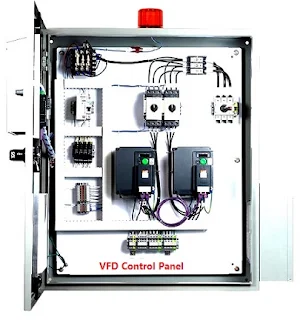What is a VFD Control Panel?
 |
| VFD Control Panel |
Variable frequency drives are an essential part of any manufacturing plant. Its continuous operation is necessary to maintain the production of the plant, How to use VFD control panel and any failure results in a chain reaction, effectively bringing the entire industry to a standstill.
Manufacturing plants are notorious for their harsh work
environments, ranging from moisture to dirt to rust. Variable frequency drives
(VFDs) may come in a protective shell, but still require protection from the
elements as well as a comprehensive enclosure for all associated equipment,
thus, having a VFD control panel for the plant becomes mandatory.
Like any other enclosure or control panel, a VFD control panel consists of an enclosure, VFD, and associated equipment such as:
harmonic filter.
Protection devices such as relays, circuit breakers, and
stabilizers.
PLC for advanced control.
Communication devices such as switches and modems.
Temperature control devices such as anti-condensation
heaters or air conditioners.
motor starters.
VFD control panels are used for four primary reasons such as:
1.) Power Switching and Protection
VFD panels usually host a circuit breaker or a relay which can
trip in case of any fault like short-circuit, overload, etc. to the input power
line
2.) Adjustable speed
Typically, the VFD panel door has a frequency control
potentiometer installed to transmit a command signal to the motor according to
the operator's setting. A bypass switch is located nearby to allow the motors
to function in case the VFD fails.
3.) Protection from the environment
This is one of the major concerns for any control engineer
as manufacturing units are clogged with moisture, dirt, etc., which can result
in short-term and long-term problems. Chemical buildup over an open connection can usually result in reduced performance while dirt accumulation can lead to a
shorter lifespan for the drive.
4.) Visual Control
VFD panels are not just positioned for protection against
harsh conditions. Multiple field indicators are installed to obtain real-time
information about the drive's power consumption, frequency, and other diagnostic
information that is required of the operator. In addition, controls are
embedded to allow the operator to shift the frequency or take precautionary
action based on monitored values.
The National Electrical Manufacturers Association (NEMA) is responsible for creating different resistance levels for enclosures depending on their use.
Type 1: Drip-tight, similar to Type 1 but with additional
drip shields.
Type 2: Weather resistant, protects equipment from dripping
rain and rice.
Type 3R: Intended for outdoor use.
Type 4: Watertight, equipment must be protected from at
least 65GPM of water.
Type 5: General purpose, provides protection against solid
foreign objects such as dirt, dust, lint, etc., while shielding against water,
dripping, oil spillage, and non-corrosive coolant.
The type of protection to be provided by the VFD panel
should be selected about the NEMA guidelines to maintain
maximum utility and safety of the instruments, and hence, minimum asset
downtime.







0 Comments
Leave a Reply...